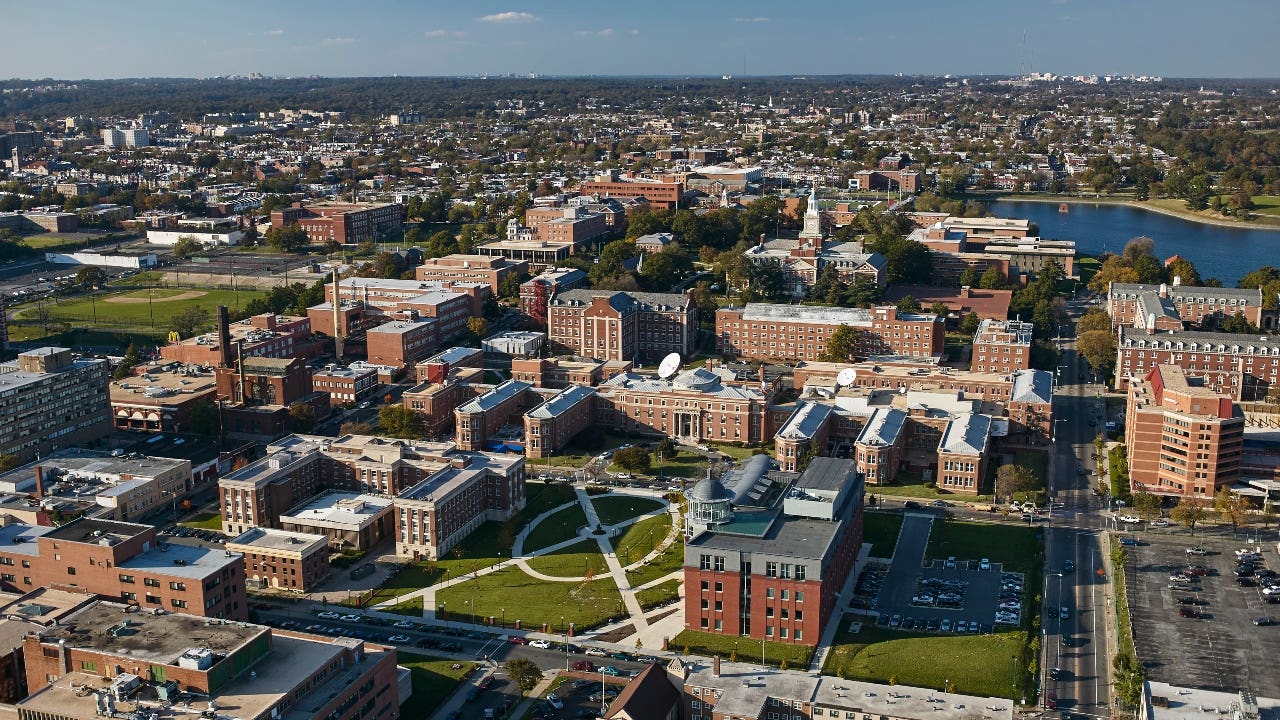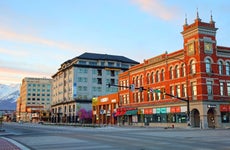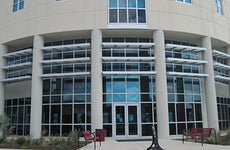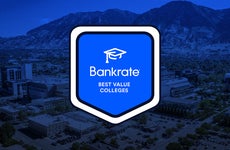The best HBCUs of 2023

The Bankrate promise
At Bankrate we strive to help you make smarter financial decisions. While we adhere to strict , this post may contain references to products from our partners. Here's an explanation for .
Historically Black colleges and universities — commonly known as HBCUs — are higher education institutions founded before 1964 whose primary mission is to educate and promote the progress and advancement of Black Americans.
Today, there are over 100 HBCUs across the country, and Black students make up 75 percent of the enrollment at these institutions.
The colleges featured in our list represent the best when it comes to the social and economic mobility they provide to their students. They’re affordable, with low student-to-faculty ratios. They also have higher-than-average graduation rates and their graduates often secure good-paying jobs.
The top 8 HBCUs of 2023
University of Maryland Eastern Shore: Best HBCU for a vibrant campus experience
- Average annual net cost: $11,662.
- Student-to-faculty ratio: 11:1.
- Graduation rate: 44 percent.
- Average financial aid award: $7,547.
- Median alumni earnings: $43,696.
The University of Maryland Eastern Shore boasts an impressive 1,100-acre campus, complete with a recreation center, 10 residences and a variety of dining options. When it comes to academics, undergraduates have plenty of choices — starting with conventional majors, like marketing or accounting, to more unique offerings, such as aviation science or professional golf management. The school has more than 60 clubs and organizations, including intramural sports teams, fraternities and sororities, in addition to over a dozen NCAA Division I teams. Each year, the university reports that most of its full-time undergraduate students receive some form of financial aid.
Howard University: Best HBCU for research opportunities
- Average annual net cost: $45,837.
- Student-to-faculty ratio: 14:1.
- Graduation rate: 62 percent.
- Average financial aid award: $21,106.
- Median alumni earnings: $59,441.
Howard University’s campus may be on the smaller side compared to others on our list. Its academic offerings and prime location in the heart of Washington, D.C., more than makes up for that.
The institution has an R2 Carnegie classification, meaning it invests significant money in research each year. The National Science Foundation has also recognized the university as one of the nation’s top producers of African American students who go to earn science and engineering doctoral degrees. Howard University also offers students more than 200 clubs, 21 NCAA Division I sports teams and several Black Greek organizations for a well-rounded college experience.
Virginia State University: Best HBCU for agricultural science
- Average annual net cost: $15,359.
- Student-to-faculty ratio: 12:1.
- Graduation rate: 44 percent.
- Average financial aid award: $10,778.
- Median alumni earnings: $43,364.
Virginia State University offers a vast academic curriculum with over 30 bachelor’s degree programs in such as hospitality management, education, criminal justice, social work and music.
VSU is the place to be for students interested in agriculture. The school’s College of Agriculture offers seven specialties, including agriculture business economics, animal science and agribusiness management. The College of Agriculture has also won multiple awards, including the Award of Excellence at the State Fair of Virginia. It is home to the Virginia Cooperative Extension and the VSU Agricultural Research Station — both fundamental to Virginia’s local community.
Morgan State University: Best HBCU for engineering majors
- Average annual net cost: $16,645.
- Student-to-faculty ratio: 17:1.
- Graduation rate: 47 percent.
- Average financial aid award: $8,423.
- Median alumni earnings: $46,092.
Morgan State University is the largest HBCU in Maryland and the only college whose entire campus is considered a National Treasure by the National Trust for Historic Preservation. The school offers more than 140 academic programs, ranging from baccalaureate to doctoral degrees.
The Clarence M. Mitchell Jr. School of Engineering is one of the school’s most notable departments, producing the highest number of African American graduates in the State of Maryland and the highest number of African American electrical engineering graduates in the country. The university is the only HBCU with a transportation and urban infrastructure studies program. It also has a newly minted mechatronics engineering degree and other engineering majors, like civil engineering and industrial and systems engineering.
Spelman College: Best all-women HBCU
- Average annual net cost: $29,102.
- Student-to-faculty ratio: 11:1.
- Graduation rate: 77 percent.
- Average financial aid award: $12,830.
- Median alumni earnings: $57,578.
There are only a few dozen all-women colleges left in the country, and Spelman is one of them. Spelman has the highest graduation rate on our list, with an impressive 77 percent. The National Science Foundation has also recognized the school as a leading producer of Black women who go on to earn a doctorate in science, and its students have been selected to win important awards, such as the Truman and Marshall scholarships.
Not everything is academics at Spelman College. The school also has more than 85 clubs and organizations, in addition to a wellness center that offers sound therapy, meditation sessions and group fitness classes student quality of life.
Xavier University of Louisiana: Best HBCU for natural and health sciences
- Average net tuition: $18,445.
- Student-to-faculty ratio: 13:1.
- Graduation rate: 52 percent.
- Average financial aid award: $18,386.
- Median alumni earnings: $50,802.
Xavier University of Louisiana started as a Catholic university, but it has since opened its doors to qualified students from all backgrounds. Located near the heart of vibrant New Orleans, Xavier is a top choice for students interested in pursuing a career in natural or health sciences.
Xavier has been ranked by the Association of American Medical Colleges as one of the top 10 schools in sending African American graduates to complete medical school. The school ranks sixth among HBCUs in funding from Health and Human Services and third in receiving funds from the National Institutes of Health in Louisiana. The Louisiana Cancer Research Consortium backs its cancer research programs.
Florida A&M University: Best HBCU for STEAM degrees
- Average net tuition: $12,479.
- Student-to-faculty ratio: 14:1.
- Graduation rate: 56 percent.
- Average financial aid award: $10,178.
- Median alumni earnings: $43,616.
Sitting atop one of the seven highest hills in Tallahassee, Florida, A&M University has one of the best views. The school is home to nearly 10,000 students from all over the nation and 70 other countries, making it one of our list’s largest and most diverse schools.
According to the university, one-third of its students are enrolled in STEAM degrees — and rightly so, as the school has a lot to offer in that department. FAMU has 98 degree programs, 14 colleges and schools and 17 research centers, including one dedicated to the study of future renewable energy delivery and another one dedicated to intelligent systems, control and robotics.
Tuskegee University: Best HBCU for aerospace science engineering
- Average net tuition: $34,926.
- Student-to-faculty ratio: 9:1.
- Graduation rate: 60 percent.
- Average financial aid award: $18,857.
- Median alumni earnings: $43,878.
Tuskegee University holds many badges of honor. It’s the only HBCU designated as a National Historic Site by U.S. Congress, its nursing program was the first in Alabama. It produces more African American general officers in the military than any other institution. But one of its highest points of pride is being the only HBCU to offer an aerospace science engineering degree. The school is the top producer of African American aerospace science engineers in the nation; its graduates work for the U.S. Armed Forces, NASA and other government agencies and are considered pioneers in the aerospace industry.
Should you attend an HBCU?
There are many benefits to attending an HBCU — even if you’re not a Black student:
- Affordability: The cost of attending an HBCU is usually much lower than that of attending a non-HBCU institution. According to the United Negro College Fund (UNCF), HBCUs cost an average of $24,796 a year, compared to $34,365 at non-HBCU institutions. That represents a 28 percent difference.
- Better learning environment: Because HBCUs tend to be smaller than other institutions, they have a lower student-to-faculty ratio, which means that you get more individualized attention, more mentorship opportunities and better chances to network with other students.
- Cultural legacy: Some of the country’s most influential figures, including Vice President Kamala Harris, Oprah and Dr. Martin Luther King Jr., attended HBCUs. Because of this, many students feel greater passion to thrive in these institutions, as they feel obliged to honor and continue their school’s rich legacy.
- Good-quality education: Although UNCF estimates that HBCUs represent only 3 percent of all four-year nonprofit schools, they enroll 10 percent of all Black students and produce roughly 20 percent of all Black graduates in STEM.
But despite these benefits, there are also some drawbacks to consider when attending an HBCU. For instance, HBCUs are largely underfunded, so they often lack state-of-the-art facilities that may be available at other institutions, and they aren’t able to provide as much aid to students as non-HBCU colleges. Lower funding also means they’re often short-staffed, leading to a more inefficient administration, which can be frustrating.
Still, whether going to an HBCU is the right choice for you will depend on what you value the most. If you want to have a quality education and be part of a close-knit community where you get to know most of your peers and faculty, attending an HBCU may be the right choice. However, if you’re all about the big campus experience and crave a more individualistic approach, you may be better off looking into other options.
Methodology
To find the best HBCUs, Bankrate evaluated over 100 institutions using four key factors: degrees offered, graduation rate, student-to-faculty ratio and alumni earnings.
Degrees offered
We wanted to highlight colleges that offered the most economic mobility for its students, and part of that is offering not only associate degrees but also more advanced degrees, like baccalaureate and master’s, which provide a higher salary boost for graduates.
Using this as a guide, we eliminated schools that offered only an associate degree and nothing more, in addition to those that only catered to graduate students.
Graduation rate
One of the key indicators that a postsecondary institution is serving its students is its graduation rate. For HBCUs, the average graduation rate is about 35 percent. Using data from CollegeScorecard, we checked each of the colleges’ graduation rates, selecting those with graduation rates above the 35-percent mark.
Student-to-faculty ratio
According to a recent study by Strada, Black students who attended HBCUs reported experiencing a better learning environment and higher levels of engagement than their peers at non-HBCUs, thanks to the support and mentorship they got from professors. This also allowed them to feel better prepared to enter the professional world after finishing school.
A lower student-to-faculty ratio directly correlates to more individualized attention and increases meaningful interactions between students and their professors. That’s why we looked at each of the institution’s student-to-faculty ratio, cutting institutions where this measure was above 17:1.
Alumni earnings
Student success is measured by how well they do after school, specifically regarding early career earnings.
Using data from College Scorecard, we looked at the median alumni earnings for each of the institutions and selected schools that offered the most economic mobility by helping graduates secure good-paying jobs.
Related Articles



